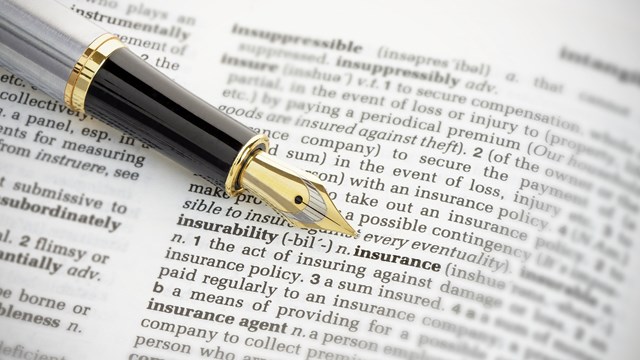
With news of foreclosures raging about them and common fee delinquencies on the rise across the nation, condominium boards are taking a long, hard look at association expenses. But, professionals caution, boards should be wary about taking that red pen to the line item that reads “insurance.”
Boards, and individual homeowners, thinking about taking a hatchet to that budget item would be wise to considerthe Florida condominium association that tried the tactic. “They dropped their insurance completely in the fall, and then in the spring, one building – 30 units – burned to the ground,” Chris Snow, principal of Bernier and Snow Insurance in Rochester, New Hampshire, says.
Before slicing and dicing the insurance policy, boards and homeowners alike “have to understand their appetite for risk,” says Bernie Gitlin, principal of Global Insurance Network in Needham, Massachusetts. “There are certain things they may want to risk and other things that you absolutely do not want to risk.” It’s essential, of course, that the “bricks and mortar” – the condominium buildings themselves – be covered for replacement cost. But insuring a condominium means more than covering the physical plant.
The association, and the volunteers who give their time and talent to keepit running, need to be covered, too. And unit owners need to remember that while the association’s insurance policy covers the buildings, it doesn’t cover their personal property – from the comfy couch to the treasured collection of Elvis recordings.
And yet, according to a recent survey compiled by Rasmussen Reports, 13.4 percent of the homeowners interviewed said they never review the insurance coverage on their homes. The survey, conducted for Country Financial, revealed that although 46 percent of the homeowners said the majority of their net worth is represented by the equity in their home, only two percent said that having the right level of insuranceprotection is their biggest financial priority. And, the survey found, a majority of Americans only have coverage to rebuild 80% of their home.
That mindset must be understood – and overcome – by board members who bear the responsibility of protecting their community association’s assets. “You really need to understand your condominium documents,” Snow says. “They can be intimidating, and peopledon’t want to spend the time studying them. But it’s important to know what they say about issues like this.”
Are You Covered?
So what level of insurance should the condo board and individual homeowners be thinking about?
“You have to get a handle on the replacement cost” of the property, Gitlin stresses. “One hundred percent of condominium documents call for [covering] replacement cost.” And this is no place for guessing. “You can get at the number in a number of ways,” Gitlin says. “One is by having a replacement cost appraisal done. A second way is through your insurance company, because most companies we deal with have some kind of a cost estimator.” Those computerized estimators work pretty well for most buildings, he notes – but boards responsible for high-end properties, or historic buildings outfitted in bronze and mahogany, will want to take a more personalized approach to the job.
Fortunately, Gitlin says, “you can usually bite that bullet once, going through every unit,” to give a baseline for future work.
But, the professionals caution, “replacement cost” is a starting point – not the final goal. “The big coverage to think about now is building ordinance,” Snow reports.
Building ordinance or law insurance covers the cost of bringing a damaged structure up to current building codes – which are likely to be more stringent than the code that was in force when it was built. “Most buildings that are 20 years or older are not 100 percent up to current building codes,” Gitlin says. The standard insurance policy covers “replacement of what is there, but then the building inspector comes in and says you need to bring it to (today’s) code.” That might mean, he says, that battery-operated smoke detectors have to be replaced with a hard-wired system, or that a sprinkler system must be installed – considerablyincreasing the reconstruction costs.
In New England, Gitlin says, the condo association policy usually covers the entire structure, including the kitchen and bath cabinets; in other parts of the country, the association coverage often stops at the studs and everything inside the unit is the individual owners’ responsibility. Because of this, boards should be kept apprisedof improvements – like kitchen renovations – made within units, since the association policy covers them.
But that doesn’t mean homeowners are entirely off the hook. Association policies include deductibles – and in case of a disaster, the homeowner will have to cover the deductible. In today’s market, professionals note, deductibles are rising, because that’s one way associations can trim their costs. Those deductibles can vary widely, but Snow says, “If we see a deductible of more than $5,000, we have a letter we send to the board” suggesting they make sure that homeowners are aware of that cost. Boards, Gitlin notes, “are trying to keep rates under control and give the unit owners some responsibility,” but homeowners need to be aware of their responsibility.
And as anyone who’s watched the news over the past few years knows, flood insurance isn’t a bad idea, either – even if the condo isn’t beachfront property. “Forty percent of losses happen outside of the flood zone,” Snow notes. “Snow melts, dams break, rivers rise. We’re not talking about tidal waves, just regular day-to-day stuff,” like the rain-driven flooding that hit New England this spring.
More to Consider
Once the structure and the homeowner contents are covered, though, the board isn’t through with its duty.
“Virtually any condo, even if you don’t have amenities and potential problem areas, ought to carry at least a couple million dollars of liability insurance,” Gitlin cautions. “And if you have a gym, swimming pool, or other amenities that could produce injury, you want to be sure you have a significant liability amount. Today, that’s cheap to do. If somebody gets hurt as a result of (poor) maintenance, there could be very serious liability.”
And don’t forget the people. Associations should carry insurance covering both employees – the management team – and the volunteers who serve on the board.
“In Massachusetts, if you have more than 10 units, you have to buy fidelity coverage,” Gitlin says. The state condominium statute, Chapter 183A, spells this out in no uncertain terms: “The organization of unit owners in condominiums of more than ten units must secure and maintain, at its own cost and expense, blanket fidelity insurance coverage insuring against the dishonest acts of any person, trustee, manager, managing agent or employee, or the organization of unit owners who is responsible for handling organizational funds, in an amount equal to atleast one-fourth of the annual assessments, excluding special assessments.”
Reports of theft and fraud crop up frequently in the news these days, an indication that the framers of the state law knew what they were doing. Think it can’t happen here? It has – and probably will continue to happen, the professionals predict. Insurance may not prevent the problem, but it will protect the association.
And while those news reports occasionally focus on unscrupulous activity by board members, board members more often are the ones who need insurance protection. “From the board’s point of view, even more important than the fidelity insurance is Directors & Officers (D & O) insurance,” Gitlin says. “In my judgment, anyone who serves on a board that doesn’t have D & O insurance ought to have their head examined.”
D & O insurance protects directors and officers from damages resulting from allegations of wrongful conduct and lawsuits stemming from their official duties. Board members are expected to perform their fiduciary duties in the manner of an ordinary, prudent person – and most do. But when problems arise, these volunteers should know that the association has their back. “If you’re a volunteer,” Snow says, “you don’t want to put yourself out on a limb; you want the best coverage you can get.”
“Most boards are honest, and try to do the right thing,” Gitlin agrees. “But strange things happen…. And you don’t want to risk your assets while serving as a volunteer.” Board memberscan be targeted for any number of issues, ranging from their handling of elections to the way they maintain financial records. It’s difficult enough to get owners to run for seats on the board, without expecting them to put themselves at risk for doing it.
While many umbrella insurance packages have D&O coverage embedded in them, Gitlin and Snow suggest that boards take a close look at the coverage – and may well want to pay for a separate policy. “Those embedded policies are often generally inferior to what you can buy with a separate stand-alone policy, even when the same company is writing both,” Gitlin says.
And, Snow notes, this is a prime example of the adage that “cheaper is not always better.”
Those are words of wisdom in this age.
“Associations today are trying to cut expenses, and too often they are enamored with a premium that looks low,” Gitlin says. “But then, after the loss, they want to know why it isn’t covered. There are differences betweenpolicies. Just be sure before you give up coverage, you understand what you’re giving up.”
Pat Gale is associate editor of New England Condominium magazine.






Leave a Comment